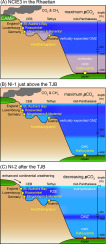当前位置:
X-MOL 学术
›
Earth Sci. Rev.
›
论文详情
Our official English website, www.x-mol.net, welcomes your
feedback! (Note: you will need to create a separate account there.)
Redox conditions and nitrogen cycling during the Triassic-Jurassic transition: A new perspective from the mid-Panthalassa
Earth-Science Reviews ( IF 10.8 ) Pub Date : 2020-05-01 , DOI: 10.1016/j.earscirev.2020.103173 Wataru Fujisaki , Yusuke Fukami , Yohei Matsui , Tomoki Sato , Yusuke Sawaki , Katsuhiko Suzuki
Earth-Science Reviews ( IF 10.8 ) Pub Date : 2020-05-01 , DOI: 10.1016/j.earscirev.2020.103173 Wataru Fujisaki , Yusuke Fukami , Yohei Matsui , Tomoki Sato , Yusuke Sawaki , Katsuhiko Suzuki

|
Abstract We determined redox-sensitive element concentrations along with δ15NTN values from the Triassic-Jurassic shales interbedded within deep-sea cherts at the Katsuyama section, SW Japan, to clarify the redox and related nitrogen cycle conditions in mid-Panthalassa during the TJB biotic crisis, focusing particularly on the linkages with CAMP volcanism. Slight enrichments of Mn and Mo across the TJB suggest a vertically expanded mid-Panthalassic OMZ above a well‑oxygenated deep ocean. Moreover, high-resolution δ15NTN records during the Triassic-Jurassic transition exhibit a negative nitrogen isotope excursion (NNIE) just above the TJB. Relative to the previously reported negative carbon isotope excursion (NCIE) across the TJB, the NNIE can be divided into two intervals: negative interval 1 (NI-1) during the NCIE and NI-2 after the NCIE. The NNIE can be explained as an interval of nitrate-rich conditions, reflecting an oxic Panthalassic Ocean during the Triassic-Jurassic transition. Our geochemical dataset provides new insights into environmental perturbations in mid-Panthalassia during the TJB biotic crisis: (1) a vertically expanded OMZ and decreased primary productivity owing to global warming caused by CAMP volcanism across the TJB resulted in an increased nitrate concentration during the NI-1, and (2) eutrophic, nitrate-rich conditions developed in mid-Panthalassa during the NI-2 due to the enhanced continental weathering and deep-water upwelling. Significantly, our results are the first to demonstrate that the OMZs were expanded not only in the shallow-marine regions, but also in pelagic sites across the TJB, suggesting that the globally expanded OMZs can be regarded as a crucial driver for the TJB biotic crisis.
中文翻译:

三叠纪-侏罗纪过渡期间的氧化还原条件和氮循环:来自中潘塔拉萨的新视角
摘要 我们确定了三叠纪-侏罗纪页岩中的氧化还原敏感元素浓度和 δ15NTN 值,这些页岩夹在日本西南部 Katsuyama 部分深海硅质岩内,以阐明 TJB 生物危机期间 Panthalassa 中部的氧化还原和相关氮循环条件,特别关注与 CAMP 火山活动的联系。穿过 TJB 的 Mn 和 Mo 的轻微富集表明在一个充氧的深海上方垂直扩展的中泛海带 OMZ。此外,三叠纪-侏罗纪过渡期间的高分辨率 δ15NTN 记录显示出 TJB 正上方的负氮同位素偏移 (NNIE)。相对于之前报道的 TJB 负碳同位素偏移 (NCIE),NNIE 可分为两个区间:NCIE 期间的负区间 1 (NI-1) 和 NCIE 之后的 NI-2。NNIE 可以解释为富含硝酸盐条件的区间,反映了三叠纪 - 侏罗纪过渡期间的含氧泛海。我们的地球化学数据集提供了对 TJB 生物危机期间中潘大拉西亚环境扰动的新见解:(1) 由于 TJB 的 CAMP 火山作用引起的全球变暖,OMZ 垂直扩展和初级生产力下降导致 NI 期间硝酸盐浓度增加-1 和 (2) 由于大陆风化和深水上升流增强,在 NI-2 期间在 Panthalassa 中部形成了富营养化、富含硝酸盐的条件。重要的是,我们的结果首次证明 OMZ 不仅在浅海区域扩大,而且在整个 TJB 的远洋地区扩大,
更新日期:2020-05-01
中文翻译:

三叠纪-侏罗纪过渡期间的氧化还原条件和氮循环:来自中潘塔拉萨的新视角
摘要 我们确定了三叠纪-侏罗纪页岩中的氧化还原敏感元素浓度和 δ15NTN 值,这些页岩夹在日本西南部 Katsuyama 部分深海硅质岩内,以阐明 TJB 生物危机期间 Panthalassa 中部的氧化还原和相关氮循环条件,特别关注与 CAMP 火山活动的联系。穿过 TJB 的 Mn 和 Mo 的轻微富集表明在一个充氧的深海上方垂直扩展的中泛海带 OMZ。此外,三叠纪-侏罗纪过渡期间的高分辨率 δ15NTN 记录显示出 TJB 正上方的负氮同位素偏移 (NNIE)。相对于之前报道的 TJB 负碳同位素偏移 (NCIE),NNIE 可分为两个区间:NCIE 期间的负区间 1 (NI-1) 和 NCIE 之后的 NI-2。NNIE 可以解释为富含硝酸盐条件的区间,反映了三叠纪 - 侏罗纪过渡期间的含氧泛海。我们的地球化学数据集提供了对 TJB 生物危机期间中潘大拉西亚环境扰动的新见解:(1) 由于 TJB 的 CAMP 火山作用引起的全球变暖,OMZ 垂直扩展和初级生产力下降导致 NI 期间硝酸盐浓度增加-1 和 (2) 由于大陆风化和深水上升流增强,在 NI-2 期间在 Panthalassa 中部形成了富营养化、富含硝酸盐的条件。重要的是,我们的结果首次证明 OMZ 不仅在浅海区域扩大,而且在整个 TJB 的远洋地区扩大,











































 京公网安备 11010802027423号
京公网安备 11010802027423号